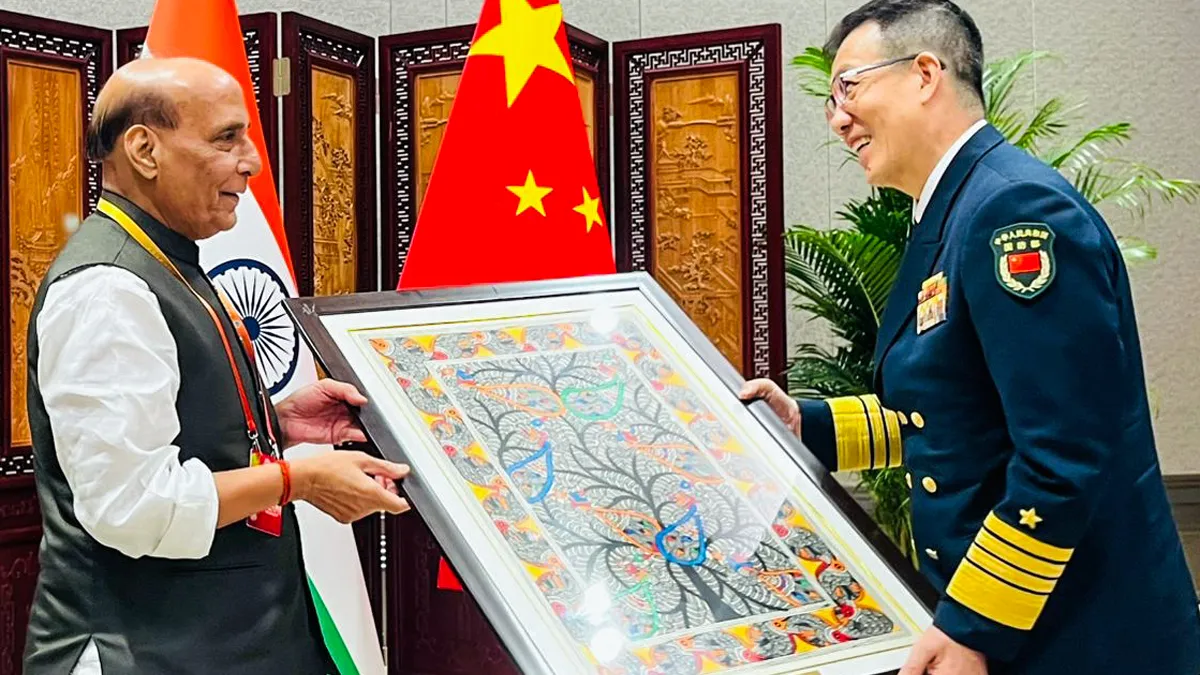- Courses
- GS Full Course 1 Year
- GS Full Course 2 Year
- GS Full Course 3 Year
- GS Full Course Till Selection
- Answer Alpha: Mains 2025 Mentorship
- MEP (Mains Enrichment Programme) Data, Facts
- Essay Target – 150+ Marks
- Online Program
- GS Recorded Course
- Polity
- Geography
- Economy
- Ancient, Medieval and Art & Culture AMAC
- Modern India, Post Independence & World History
- Environment
- Governance
- Science & Technology
- International Relations and Internal Security
- Disaster Management
- Ethics
- NCERT Current Affairs
- Indian Society and Social Issue
- NCERT- Science and Technology
- NCERT - Geography
- NCERT - Ancient History
- NCERT- World History
- NCERT Modern History
- CSAT
- 5 LAYERED ARJUNA Mentorship
- Public Administration Optional
- ABOUT US
- OUR TOPPERS
- TEST SERIES
- FREE STUDY MATERIAL
- VIDEOS
- CONTACT US
China Eyes Border Reset, Calls for Talks
China Eyes Border Reset, Calls for Talks

Why in the News?
- China said that the border dispute with India is complicated and not easy to solve.
- It also said that it is ready to hold talks on clearly marking the border (delimitation).
- This comes as both countries are making fresh efforts to reduce tension along the Line of Actual Control (LAC).
Key Highlights
- China’s Acknowledgment of Complexity
- China admitted that the border issue is not easy to resolve and involves complex issues.
- It suggested that the process may be long and will require structured, phased negotiations.
- China’s Willingness for Delimitation Talks
- China expressed readiness for talks on the delimitation of the Line of Actual Control (LAC).
- Emphasized the importance of keeping the border peaceful while resolving disputes.
- India’s Strategic Diplomacy
- Defence Minister Rajnath Singh reiterated India’s stand on respect for sovereignty and status quo.
- India emphasized the need for peaceful negotiations based on existing agreements.
- Special Representatives Mechanism and Past Agreements
- Both countries had earlier set up the Special Representatives (SR) mechanism for boundary discussions.
- Reference made to the 2005 Agreement on Political Parameters and Guiding Principles for boundary settlement.
- Context of SCO Meet
- The talks were held on the sidelines of the Shanghai Cooperation Organisation (SCO) Defence Ministers' meeting.
- The SCO summit provided a diplomatic window for bilateral discussions amid a multilateral event.
India- China Relations
|
Year |
Event / Development |
|
1950 |
India becomes the first non-Communist country to recognize the People’s Republic of China (PRC). |
|
1954 |
Signing of the Panchsheel Agreement (Five Principles of Peaceful Coexistence). |
|
1962 |
Sino-Indian War: China occupied Aksai Chin; defeat for India; diplomatic freeze begins. |
|
1988 |
PM Rajiv Gandhi’s visit to China; beginning of normalization and border dialogue. |
|
1993 |
Agreement on Peace and Tranquility along the LAC signed. |
|
2001 |
China became a founding member of the SCO. |
|
2005 |
Agreement on Political Parameters and Guiding Principles for Border Settlement. India joins SCO as an observer state. |
|
2006 |
Reopening of Nathu La pass for trade |
|
2014 |
PM Narendra Modi’s visit to China; economic agreements signed. |
|
2015 |
China begins pushing its Belt and Road Initiative (BRI); India refuses to join, citing sovereignty issues (especially China-Pakistan Economic Corridor (CPEC)). |
|
2017 |
India became a full member of SCO. Doklam Standoff near Bhutan tri-junction; face-off lasts 73 days. |
|
2018 |
Wuhan Informal Summit between Modi and Xi Jinping to reset ties post-Doklam. |
|
2019 |
Second Informal Summit held in Mamallapuram, Tamil Nadu. |
|
2020 |
Violent Galwan Valley clash: 20 Indian soldiers martyred; first fatalities in 45 years. |
|
2021 |
China passes a new Land Border Law asserting control over disputed areas. |
|
2022 |
Clash in Arunachal Pradesh’s Tawang region India joins SCO and BRICS summits virtually amid LAC tensions. |
|
2023 |
India hosts SCO summit in virtual mode; keeps China participation low-profile. |
|
2025 |
China says it's open to delimitation talks, calls the issue "complicated" but manageable. |
Implications for India
- Diplomatic Engagement
- Keeps channels of communication open.
- Could reduce the risk of escalation and promote dialogue-based solutions.
- Border Management
- Delimitation talks may stabilize the LAC in certain sectors.
- Can help avoid incidents like Galwan and Doklam if consensus evolves.
- Regional Stability
- Progress on boundary talks may positively impact India’s broader regional influence.
- May also contribute to SCO’s peace and security goals.
- Strategic Calculations
- India must balance engagement with firmness on sovereignty.
- Carefully observe China’s strategic intent behind the softened tone.
- Military Preparedness
- Despite talks, India must remain militarily vigilant along the LAC.
- Infrastructure development along the border should continue.
About Shanghai Cooperation Organization (SCO)
Organizational Structure
Significance of SCO
|
SCO and India
- Importance for India
- Counter-Terrorism Cooperation: Shared platform to counter cross-border terrorism, especially relevant given India’s security concerns with Pakistan.
- Regional Stability: Gives India a voice in regional peace efforts and access to Central Asian diplomatic engagements.
- Connectivity and Energy Access: Offers a route for India’s Connect Central Asia policy and potential energy partnerships.
- Economic Opportunities: Expands India's access to markets, investment, and infrastructure projects in the region.
- Multilateral Diplomacy: A valuable platform for India to balance relations with China and Russia while asserting its own interests.
- Challenges for India
- Balancing Rivalries: Navigating tensions with China and Pakistan while maintaining SCO engagement.
- Strategic Autonomy: India must balance its non-alignment policy with SCO’s increasing China-Russia orientation.
- Sovereignty Issues: India opposes BRI, especially the China-Pakistan Economic Corridor (CPEC), while all other SCO members support BRI.
- Low Economic ties:India's trade with Central Asia and Russia is much lower than China’s in the region.
- Security Tensions: Cooperation with Pakistan and Afghanistan on counter-terrorism remains difficult.
- India’s Role and Opportunities
- SCO Presidency: India hosted the SCO Summit in 2023, showcasing leadership on issues like connectivity, reform, and counter-terrorism.
- Currency Push: Promote trade in national currencies to reduce dependency on USD and boost regional economic autonomy.
- Asian Century Goals: Use SCO to build deeper trade and cultural ties across Asia.
- Tourism & Cultural Diplomacy: Leverage shared cultural heritage to promote people-to-people connections.
- Constructive Dialogue: Continue engaging diplomatically while protecting national interests.
Challenges and Way Forward
|
Challenges |
Way Forward |
|
Trust deficit post-Galwan clash |
Confidence-building measures and open communication |
|
Lack of clarity on LAC in several sectors |
Technical talks on delimitation and demarcation |
|
China’s assertive posturing in the region |
Strengthen ties with other QUAD and Indo-Pacific nations |
|
Prolonged negotiation history |
Set clear timelines and milestones for dialogue |
|
Risk of local flare-ups |
Maintain strong military readiness and surveillance |
|
Ensure IAS Mains Question Q. Discuss the complexities involved in the India-China boundary dispute. In this context, critically analyze the role of bilateral mechanisms like the Special Representatives (SRs) dialogue in promoting peace and delimitation talks. (150 words) |
|
Ensure IAS Prelims Question Q. With reference to the India–China boundary dispute, consider the following statements:
Which of the statements given above is/are correct?
Answer: c Explanation Statement 1 is correct: The 2005 Agreement on Political Parameters and Guiding Principles was signed between India and China to serve as a basis for boundary settlement negotiations. Statement 2 is correct: Delimitation refers to clearly marking the boundary. Talks on delimitation between India and China aim to define the Line of Actual Control (LAC) more clearly to prevent future stand-offs like Galwan or Doklam. |
|
Also Read |
|
| FREE NIOS Books | |




